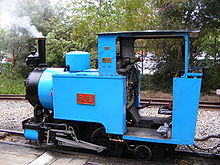- National Railway Museum (Port Adelaide)
-
The National Railway Museum, Port Adelaide, South Australia, is the current site of the Port Dock Station Railway Museum's vast Australian Railway Collection.
Contents
History
The museum was founded in 1963, by a group of rail preservationists who managed to convince the South Australian Railways Commissioner to allocate land on the site of the former Mile End Roundhouse to house a small collection of withdrawn steam locomotives. The original site, on Railway Terrace Mile End, had only a small number of exhibits under cover. Most items had to be housed on the site in the open air. The effects of weather took their toll on the exhibits, so an alternative undercover venue was sought.
In 1988 the Museum was fortunate enough, with the involvement of the History Trust of SA, to obtain a $2m Australia's bicentennial Commemorative Grant to relocate to its current site and to provide covered accommodation for the exhibits. On 2 January 1988 the gates at the Mile End Railway Museum closed for the last time and on 10 December 1988, after almost a year of frantic activity, the Port Dock Station Railway Museum Port Adelaide was officially opened by the Premier of South Australia, The Hon John Bannon.
In 1999, special funding was received as part of Australia's Centenary of Federation to construct the Commonwealth Railway Museum within the museum's precinct. This new facility, which was opened on 21 October 2001, houses a representative sample of exhibits from the "Commonwealth Railways" and "Australian National". Included is the original Tea and Sugar train, as well as a number of vehicles that were used on the Ghan and Trans-Australian passenger trains.
At the opening of the Commonwealth Railway Museum the Port Dock Station Railway Museum was renamed the National Railway Museum. The name change is a response to the Commonwealth Railways operations being integrated into a National Transport Network that spans the whole of the Australian continent.
Collection
The museum currently houses their large static collection in two pavilions and the historical goods shed at the site of the original Port Dock railway station. On the site, all three gauges of Australia are represented, these being Narrow (3' 6" or 1067mm), Standard (4' 8½" or 1435mm) and Broad Gauge (5' 3" or 1600mm). Operational locomotives and railcars on these gauges respectively are Steam locomotive Peronne (1918 Andrew Barclay 0-6-0 Tank Locomotive), DE 507 (South Australian Railways) and 801 (SAR), Redhen Railcars 400, 321 and trailer 863. The museum also operates a number of 18" gauge (457mm) equipment, mainly steam locomotives Bub (0-4-2T) and Bill (2-4-0 with 4 wheel tender).
In 2008 the museum received the 1949 Overland roomette sleeping car Allambi, donated by the Victorian Government after being stored after the end of the Vinelander service.[1][2]
Buildings
The museum has a number of historic buildings, some original to the site and other transported for display. Amongst the more historic of these are:
Goods Shed The original Port Dock Station Goods Shed is included as part of the Museum complex. This building is constructed of large timber beams and is typical of the type of buildings constructed by the South Australian Railway in the 19th Century.
Woodville Signal Cabin The former Woodville signal cabin of the South Australian Railways/State Transport Authority has been moved to the Museum site and connected to the narrow gauge yard. It is available for tours.
Callington Station The "Callington Shelter Shed and Booking Office" is typical of the type of building used by the South Australian Railways at small country stations. It was originally built in 1951 for the then small rural community of Callington, located approximately 20 km west of Murray Bridge on the main Adelaide to Melbourne route.
Intense competition during the 1960s and 70s with road transport, for passenger and parcels traffic, eventually resulted in the withdrawal of all staff and the closure of Callington station. Following closure, the building was subject to extensive vandal attacks that left nothing but the exterior. In 1991 an approach was made to Australian National, who agreed to sell the building. This resulted in the building being purchased by a museum member, who subsequently arranged for its donation and transportation to Port Adelaide. It was placed in storage until 1994, when it was re-erected in its current location.
Eudunda Gang Shed Located at rear of the rollingstock pavilion is the former Eudunda Gang Shed. It was purchased and relocated by members of the museum in 1990
Operations
The museum operates a number of historic locomotives for shunting purposes and special events where large passenger numbers are applicable, in lieu of this, the 18" gauge steam locomotives and a diesel operate rides of 1.2 km around the museum. In 1992, the museum, in co-operation with the local council, built a 2 km line along the beach from Semaphore to Fort Glanville. This is operated from October to April, weekends, public holidays and school holidays when temperatures are below 35 degrees celsius. The line travels along the coastline, through the sand dunes and the Fort Glanville Conservation Park, with the engine being turned and run around at each end of the line, which is a delight for tourists who enjoy the beachside trip.
See also
References
- ^ Candice Marcus (November 28, 2008). "Vintage rail carriage makes road trip". ABC News. www.abc.net.au. http://www.abc.net.au/news/stories/2008/11/28/2432935.htm. Retrieved 2008-12-02.
- ^ "Who owns SZ287 & SJ cars". Railpage Australia Forums (Locomotives and Rolling Stock). www.railpage.com.au. http://www.railpage.com.au/f-t11343946-s15.htm. Retrieved 2008-12-02.
- The Guide to the National Railway Museum (2003), The National Railway Museum website
Coordinates: 34°50′44″S 138°30′31″E / 34.8455°S 138.5085°E
Categories:- Museums in Adelaide
- Railway museums in Australia
- National railway museums
Wikimedia Foundation. 2010.




